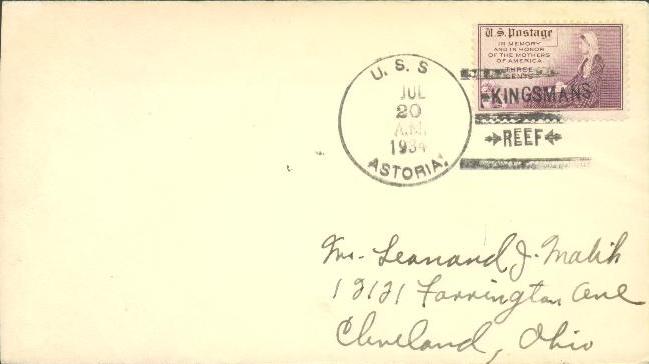
ARTICLE: It is fun to collect the Pacific
FORUM: introduction to the Pacific collection. Thanks to Eric for his useful article!
The article is published, for the first time, on the Cinderella Philatelist of London, in the July issue 2006.
Editorial (by
fabioV)
Hello dear readers, today I would like to astonish you
speaking of “impossible collections”, just to begin a discussion among those
who want to explore the limits of geographical philatelic collecting.
As you know I am an ASFE
(A Stamp From Everywhere) collector
and I always tried to enlarge the boundaries of my collection inserting new
locations, both if they were serviced by a true local post, or by a purported
local service which “issued” phantom stamps. About phantom philately we will
speak another time, while today I would like to put to the attention of our
readers an incredible collection. We could name it APFE that means “A POSTMARK
FROM EVERYWHERE”. Of course such collection is so large that it is impossible
to complete it. By the way I discovered that in 2004
there were 663.000 permanent post offices in the world. So a simple
collection of 1 postmark from each different active post office will be almost
equal to collect ALL the stamps issued from May 1840 to April 2006, which are
683.689: surely impossible.
But fortunately the
boundaries of a collection are fixed by the collector himself, so everybody can
decide what to collect. For example, a collector could choose to make
a very peculiar collection: “A Postmark From Every Desert Island”, of
course at the first glance it is a provocation, because if an island is desert
surely there are no post offices and even people to write or receive letters. In
fact when I checked the US territories far from mainland,
I was attracted by peculiar names as: Navassa island, Palmyra atoll,
Kingman reef, Baker island and
others. So I tried to find out if there were covers with postmarks from those
locations. Well, I discovered that for a long period, among the two world war,
all the U.S. ships which cruised or patrolled the oceans were used to
cancel the covers with data and
killer bar postmarks which had also the name of the island or harbour
they were in front that day. Even during the second world war
troops occupied strategic desert islands and from
there they wrote letters which are identified by different APO codes. (see
in fig.1 a Kingman reef cover and in fig.2 a Baker island cover with APO
457). So also the uninhabited islands can have their postmarks!
After the above considerations I can now introduce Eric
Baxendale, who has collected the postmarks and Postal History of the Pacific
islands for many years. Eric will help with his
advice on how some of
us could begin a collection based on the postmarks of the Pacific islands!

fig.1 cover from U.S.S. Astoria on the 20th July 1934, during her patrol in front of Kingman reef (high resolution)
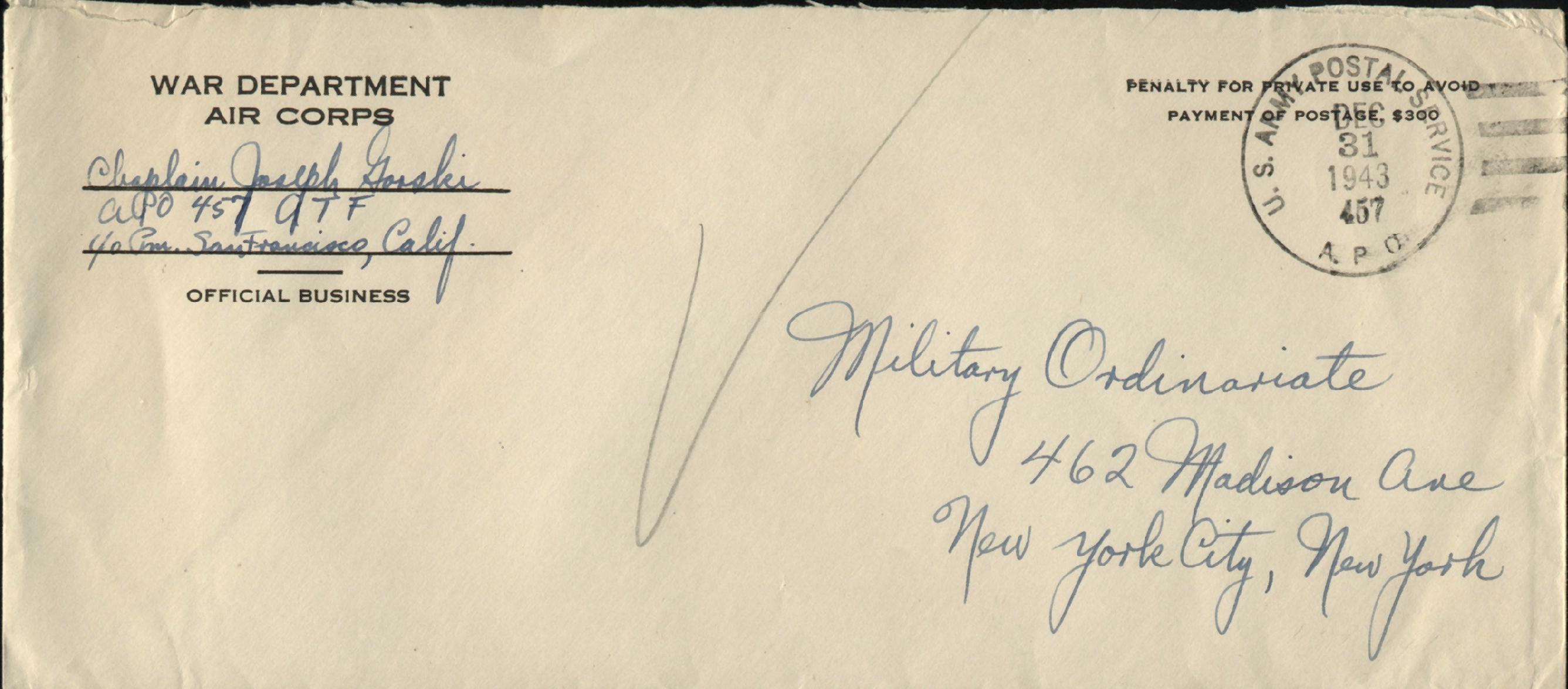
fig.2 cover from Baker island (high resolution)
"A.P.O. 457 DEC 31, 1943", this Cover was mailed by Chaplain Joseph Gorski, a Catholic Priest, & was addressed to the Military Ordinariate, 462 Madison Avenue, New York City, New York. The Military Ordinarite served as the "Superior" to all Catholic Chaplains in the Armed Services and, as this was mailed by a Chaplain, it was not subject to Censorship. This A.P.O. was located on remote BAKER island.

fig. 2a detail of APO 457 Baker island 31 Dec. 1943 (high resolution)
It's fun to collect the Pacific
Introduction
If
you open your Atlas at the Pacific Ocean you will probably see a double page
spread with a large blue area representing the sea, bounded in the East by the
Americas, in the north and west by Asia and to the south west by Australia and
New Zealand.
A
scatter of islands runs in an arc through the West and South of the Pacific
Ocean from the remote Japanese Bonin islands in the North to the lonely British
Pitcairn Island and Chilean Easter (Rapa Nui) island in the South - East. The
North and West Pacific is largely empty apart from the Hawaiian chain and a few
isolated islands.
Many
Pacific islands have or have had Post Offices, some more than one, and
collecting covers from the area can be fascinating. Many people start a
collection of the Pacific by trying to obtain a cover from every island or from
every administration. You may find it relatively easy to get a cover from every
administration but getting a cover from every island is a long term task.
Whichever route you take this is a good way of learning about the area and
getting a feel for the way the various postal organisations work.
Collecting
philatelic material from the Pacific allows us to follow again the routes of the
great explorers and air mail pioneers, to visit the islands which were
discovered by adventurers or even pirates, to visit in our imaginations the
islands known only for the terrible battles of the second world war.
But
how to get covers and postmarks from the area? And
which are the other topics for a Pacific collector? Here are some
suggestions.
What to collect?
You might decide to try to obtain a cover from every Post Office in the
Pacific, or every Post Office in a particular administration, or in a particular
year or decade. If you were to decide to collect a cover from every Pacific Post
Office open in the 21st Century you could start by writing to Postmasters
scattered across the Pacific asking them to cancel the stamps on the self
addressed envelopes enclosed. My early attempts at this were only partly
successful, not least because I often used International Reply Coupons when I
had not got the relevant stamps. These are rarely recognised other than by the
Head Post Office of the island group. It was only when I joined philatelic
societies and made contact with other more experienced collectors that I learned
how to build up a collection economically and have a lot of fun doing so. The
next paragraph contains some suggestions on how you might approach
this task.
Setting a Boundary to Your Collection
The
Pacific is a wonderful area for building up an interesting and varied collection
based on a particular island group. This is because many islands, now
independent, have been colonised by one or more outside powers during their
recent history enabling you to build a history of the country with covers from
each period.
The
possibilities are almost endless, and limited only by your knowledge and
imagination. Listed below are some island groups with interesting postal
histories which you might consider.
Kiribati
(formerly part of the British administered Gilbert & Ellice Islands Colony,
and after independence known as The Gilbert Islands for a time) is a scatter of
islands in the Central Pacific ranging from Makin and Tarawa in the west to
Christmas, Fanning and Washington islands in the East. These latter islands have
been claimed by both Britain and the U.S. Christmas
and Canton have both hosted U.S. Post Offices, and Fanning Island once hosted a
New Zealand Post Office. In the early 1960’s Christmas (Kiritimati in the
Kiribati language) island with a population counted in the low hundreds had
three Post Offices, a Gilbert & Ellice Islands Post Office, a U.S. Post
Office & a British Army Post Office. All with Christmas Island postmarks but
using, respectively, Gilbert & Ellice Island Colony, U.S. and British stamps.
Kiribati is a relatively frugal stamp issuing country. It issues only 4 or 5
sets of stamps each year.
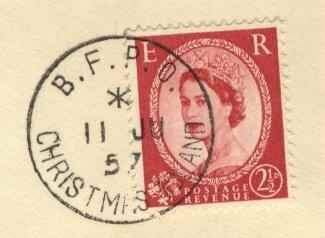
fig.3.B.F.P.O. at Kiritimati/Christmas island Pacific Ocean June 11 1957 (high resolution)
The Solomon Islands (Formerly
a British Protectorate) Geographically the Solomon Islands include the island of
Bougainville, once administered by Germany but now part of Papua New Guinea and
campaigning for independence. Some collectors include covers from Bougainville
in their Solomon Island Collections.
Solomon
Island stamps issued prior to independence are amongst my favourite Pacific
Island stamps. They are well designed and show local scenes. The country
currently has ten Post Offices and a large number of postal agencies. During the
1970’s and 1980’s while the Postal
Agencies did not cancel stamps,
they date-stamped envelopes posted through them using their named
office date-stamp. This resulted in a range of very interesting covers bearing
what might be called datestamps of origin with exotic island names such
“Paradise Postal Agency. New Georgia Islands”. Sadly they no longer do this,
but you can still find the covers in auctions. Despite the unrest which has
troubled the area for some years the ten
Solomon Island Post Offices are very willing to provide clear
cancellations to properly stamped covers. The Main Post Office in Honiara, on
Guadalcanal Island
hosts an efficient Philatelic Bureau.
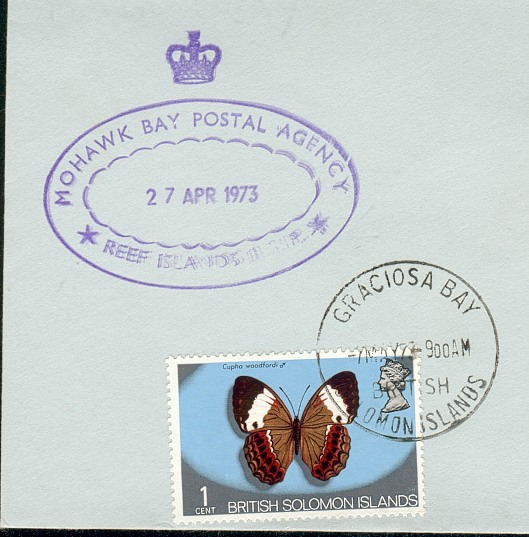
British Solomon islands: Graciosa Bay Local Agency Apr, 27 1973 (high resolution)
The Federated States of Micronesia, (FSM) is now an independent country, but the postal
history includes Spanish, German, Japanese and United States administrations.
Currently the FSMPO issues large numbers of stamps each year but many are
relevant to the islands life and history and can make an interesting collection.
The Post Office at Pohnpei has a philatelic bureau.
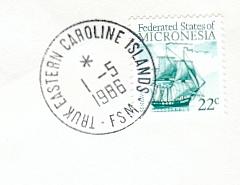
FSM: Truk Eastern Caroline May, 1 1986 (high resolution)
FSM: local postmark Feb, 27 2001 at Colonia Yap island
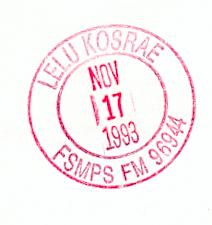
FSM: Kosrae island 1993 postmark of Lelu Nov, 17 1993
The Marshall Islands with
their German, Japanese & U.S. heritage but now independent, is another
prolific issuer of stamps, but only a small proportion are relevant to the
country. There is no philatelic bureau but an agent in the U.S. hosts a web site
through which you can purchase stamps.

Jaluit Marshall islands Japanese occupation 1935 (high resolution)
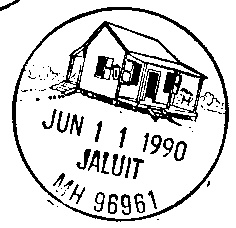
postmark of Jaluit in 1990

Enewetak atoll in Marshall islands, local postmark and local stamp on 1977 (high resolution)
Kingdom of Tonga -
if you like your collection to include envelopes with unusual stamps Tonga is
the place. For many years they issued freeform self adhesive stamps featuring, amongst other
things, stamps shaped like bananas and other fruit.
The
main colonial administrations remaining in the Pacific are the French
Territories - French Polynesia, New Caledonia, and
the Wallis & Futuna Islands. These make a nice group with lots of
interesting island postmarks and issue many colourful stamps.
A
country with an intriguing postal history is Vanuatu, formerly the New Hebrides Condominium. This group
was for many years jointly administered by Britain and France resulting in a
parallel administration which produced stamps in both French & English
Versions and Postmarks in French & English versions, and - who knows -
perhaps Postmasters in French & English versions. This practice has now
ceased.
Samoa, now partly
independent and partly under U.S. control has been under both German and British/Australian
administration in the past. American Samoa uses U.S. stamps.
The Northern Mariana Islands, now a Commonwealth of the U.S. and using U.S. stamps, have had periods
of Spanish, German & Japanese control.
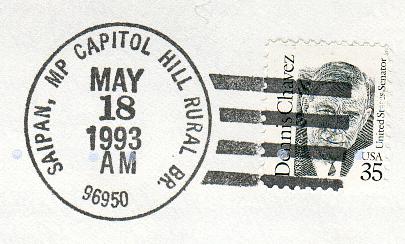
Northern Mariana islands: rural postmark Capitol Hill Saipan (high resolution)
Not
to be forgotten are the small, single Post Office, islands such as Pitcairn,
Norfolk, Easter (Rapa Nui), or Nauru). All except Easter island have
their own stamps. Easter Island uses Chilean stamps.
Other
approaches to collecting the Pacific include, for instance,
(i)
Collecting covers used during one or more of the colonial administrations.
Kiribati, Tuvalu and the Solomon Islands were for many years British colonies.
During that period many attractive stamps were issued illustrating island life
and philatelically produced covers from the 1950’s & 60’s in particular
are relatively easy to obtain and sometimes have interesting transit postmarks
and markings, indicating the route taken from the island to Europe or the U.S.
(ii)
Only of covers bearing the stamps of one particular British King or Queen.
(iii)
Only covers of a particular independent territory.
(iv)
Only of the say the Spanish administration, or the German Administration, or the
Japanese Administration or the U.S Administration in the case of Mariana,
Caroline or Marshall Islands. Another
approach could be to collect one cover from each colonial administration from
each Post Office which existed in all the different colonial administrations.
(v)
To record the history of the
airmail services in the Pacific.
During
the 1930's and 1940's commercial companies developed airmail/passenger routes to
and through the Pacific to Asia and Australia. These early airliners had a
limited range and needed the Pacific islands as stepping stones/refuelling
points. This lead to some very remote, virtually uninhabited islands (Canton
Island, Wake Island, Midway Island) becoming aviation hubs for the Pacific with
Hotels and Post Offices. Collectors
of the time, encouraged by the airline companies who were happy to advertise
their services by putting their cachet on collectors envelopes,
recorded the Fist Flights from and to each new destination
by arranging for covers to be postmarked at the place of despatch and
backstamped at the destination. Canton Island was a particularly important hub
and many covers were posted there. Many of these covers can be found in dealers
boxes or on sale in auctions.
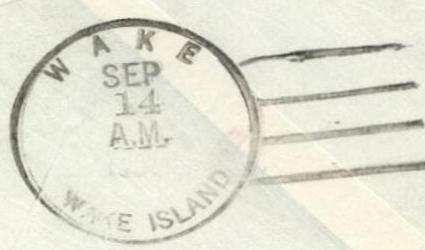
arrival postmark at Wake island Sep, 14 1953 (high resolution)

Wake island Dec, 3 1987 (high resolution)
Contacting Postal Administrations
If
you decide to write to Postmasters enclosing a stamped and self addressed
envelope and asking that they cancel the stamps the best place to start is with
a letter to the Head Postmaster or Philatelic Bureau of the island or island
group enclosing an International Reply Coupon (obtainable from large Post
Offices). International Reply Coupons can be used by Post Offices in other
countries to purchase the stamps necessary to pay the basic (often surface) rate
of postage to your country, but small Post Offices often do not understand their
use.
Most
stamp issuing administrations now have a Philatelic Bureau or at least a clerk
who specialises in dealing with collectors. Some of these will put you on their
mailing list for news of new stamp issues. Ask if you can purchase stamps by
mail and what form of payment is accepted. It is also useful to ask what the
postal rates are to your country and for a list of Post Offices, Post Office
Branches and Agencies. You may be unlucky but most Head Postmasters and
Philatelic Clerks will help.
If
you put the correct postage on your stamped and self addressed envelope when
writing to Postmasters to request postmarks you will be more likely to have your
envelope postmarked and returned.
Having
got your stamps, postage rates and hopefully a list of Post Offices it is time
to send off your request. If you don’t mind the long wait, remember that some
countries (Britain included) still have a cheaper surface rate for letters. A 20
gram letter
by surface mail from Britain to the Pacific area will cost 42p while the airmail
rate is 72p, the difference is almost enough for another letter.
Your
stamped and self addressed envelope should be accompanied by a short, clear,
legible letter explaining that you are a collector of envelopes postmarked at
Post Offices in the Pacific area and asking the Postmaster or clerk to cancel
the stamps on your envelope with a clear impression of his postmark.
If
you have language skills remember that while English is the common language of
most parts of the Pacific you are more likely to be understood in the French
islands if you write in French, and Spanish for the islands administered by
Chile.
You
will find most Postmasters will comply though you should not be too disappointed
if postmarks are only partly legible. Often Postmasters/Postal clerks in the
Pacific carry out postal work in less than ideal conditions in conjunction with
other work ranging from Radio Operator and Island administrator/clerk to
Policeman. Inkpads dry up, new supplies of ink fail to arrive, postmarks get
damaged or the dates jam and it can take months (sometimes over a year) to get
replacements. If you don’t get a response or if the postmark on your cover is
illegible don’t give up - a second try a year or so later will often bring a
better result.
Similarly
don’t be too impatient - replies sometimes take more than a year to arrive as
the only contact
with the outside world for many islands
is via a ship every few months. Even if the island has an airport the
service may be fragile using a single plane, prone to breakdown or absence for
regular servicing in Australia or the U.S.
Small Pacific Airlines often give priority to passengers & cargo over
mail which can lead to long delays to mail at peak holiday seasons. Stories of
mail piling up for months in different parts of the Pacific appear with
depressing frequency. Within the last year even the mighty U.S. Postal Service
has suffered delays in the mail service between Guam, the Northern Mariana
Islands, American Samoa and the main Pacific regional mail distribution office
in Hawaii. Having said that many covers are returned within a month or two at
the moment. Another hazard to your carefully prepared cover is damp or worse
immersion in water. Perhaps mail bags have been left out in the rain or a canoe
taking the bag out to a ship has been swamped. Whatever the reason it does
happen and the results are not pretty, but look on it as a bonus - you have a
unique cover demonstrating the problems of mail in the Pacific.
From
time to time particular Postmasters or administrations may consistently fail to
respond to requests from philatelists. Sometimes this is the policy of the
particular postal authority - this seems to be the case with Tuvalu at the
moment as only the Philatelic Bureau in Funafuti can be depended on to respond
to philatelists. Other persistent failures to respond appear to be the attitude
of a individual Postmaster who perhaps understandably doesn’t see why he
should take on the extra unpaid work of helping collectors - in this case policy
often changes when a new Postmaster is appointed.
Join
one or more Pacific orientated Philatelic Societies, starting with those which
run regular auctions - you will soon obtain a range of reasonably priced covers
to start your collection. The Pacific
Islands Study Circle is a good general society with a quarterly auction,
mostly of reasonably priced covers. It also publishes a quarterly journal
containing articles about the postal history of islands throughout the Pacific.
You can get further information about the Pacific Islands Study Circle from the Secretary, J.D. Ray 24 Woodvale Ave., London SE25 4AE - e-mail jray@dsl.pipex.com
Website
http://www.pisc.org.uk/
The
website has links to other Pacific related organisations and philatelic bureaux.
The Kiribati & Tuvalu Philatelic Society specialising, as the title says, in Kiribati and Tuvalu and in the
earlier British colonial administration of the area then called the Gilbert
& Ellice Islands Colony is another Society who have a regular auction of
reasonably priced covers from their area of interest and a journal issued 3
times a year. Kiribati & Tuvalu have many small post offices and there is a
wealth of reasonably priced material available in the Society auctions. Most
Post Offices in Kiribati currently respond to collectors requests for postmarks.
Unfortunately in Tuvalu only the Tuvalu philatelic bureau in Funafuti can be
relied on to respond to collectors letters. Both island groups have well run
philatelic bureaux (Kiribati in Tarawa, Tuvalu in Funafuti) though
communications are sometimes slow.
The
Secretary of the Kiribati & Tuvalu Philatelic Society is Michael Shaw at 88
Stoneleigh Ave., Worcester Park, Surrey, KT4 8XY e-mail j.shaw@btinternet.com
A
U.S. Society specialising the Pacific is called Oceania. The Secretary is Stuart Levan P.O. Box 24764, San
Jose, CA 95154-4764. The Website http://members.aol.com/stampsho/saso.html
has an e-mail link to Mr. Levan.
In
addition there are a number of societies who specialise in a particular island
or island group, examples are:
The
Society of Samoan Specialists:
e-mail MMiller@LadasParry.com
Website
http://members.aol.com/TongaJan/foss.html
The New Zealand Society of Great Britain for the New Zealand Dependencies - Secretary Keith C. Collins, 13 Briton
Crescent, Sanderstead, Surrey CR2 0JN).
Website:
http://www.cs.stir.ac.uk/~rgc/nzsgb/
The Pitcairn Islands Study Group - e- mail secretary@pisg.org
Website
http://www.pisg.org/welcome.html
The U.S. Pacific Islands Bulletin - a publication about the postal markings of the Caroline, Marshall &
Mariana Islands (including Guam and the Federated States of Micronesia, Republic
of Palau & the Republic of the Marshall Islands) American Samoa and the many
small islands which at some time have had a U.S. Post Office. Website: http://www.postmark-micronesia.pwp.blueyonder.co.uk/
e-mail uspibulletin@hotmail.com
I
do not know of any English language society which specialises in the French
Pacific Territories. There is the France
and Colonies Philatelic Society but a search of their website does not
indicate any material about the French Pacific Islands - See the website at http://www.fcps.org.uk/
Background Information
Read
one or more of the monthly magazines dedicated to Philately such as Gibbons
Stamp Monthly, Stamp Magazine or in the U.S. Linn’s Stamp News. Apart from the
news pages which often include Pacific related material you can find dealers who
have material available from your area of interest.
But
first you need some knowledge about the history, particularly about the Postal
History, of your chosen collecting area.
The
internet is a wonderful resource and using a search engine you will find a great
deal of information on sites set up by official organisations or collectors of
the area of your choice.
Philatelic
Societies and individuals have over many years published books on the Postal
History and Philately of various islands in the Pacific. Obtaining one or more
of these will help you discover the postal history and what is available from a
particular area of interest.
A
book I have found especially useful is "A Postal History/Cancellation
Study of the U.S. Pacific Islands (including the Trust Territory)" by
Robert T. Murphy. A long title indeed, but it covers a vast range of information
about US activities in remote islands throughout the Pacific.
Not only will you find a record of U.S. Postal activities since the
second world war in the Caroline, Marshall and Mariana Islands (The Trust
Territory) but also Guam and American Samoa since the beginning of the 20th
century. An additional bonus is a
record of U.S. postal activity in a dozen remote Pacific islands, a record of
the Naval ships visiting Pacific Islands and who included the name of the island
they were visiting that day in their postmarks and a record of Historical and
First Flights across the Pacific.
This book was published in 1983 by the American Philatelic Society P.O.
Box 8000, State College, PA 16801, USA.
When last I enquired the book was still available for purchase on-line at
$46 post paid by surface mail from https://www.stampstore.org/market_place/nonmember_shop/123shop.asp
.
The
Pacific islands Study Circle has published a number of books by members covering
aspects of the Postal History and postmarks of amongst others the Gilbert &
Ellice Islands, the Solomon Islands, New Hebrides and Fiji.
I
hope this article has been of interest to you and stimulated you to explore
further the wonderful world of the Pacific. Use your imagination and produce
something unique.
Eric
Baxendale
come back to the English Summary page .
------------------- °°°°°°°°°°°°°° --------------------
![]() SEARCH ENGINE to look up inside my website:
SEARCH ENGINE to look up inside my website:
 |
 |
|
|